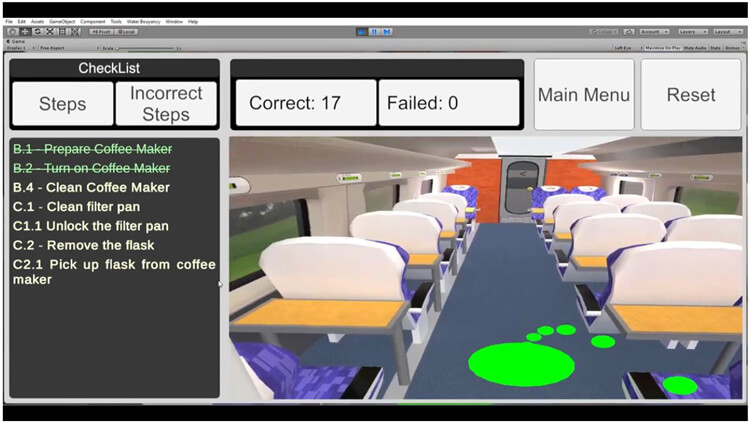Welcome to our recurring post, Rail Tech Talk, highlighting how technology is helping the Rail Industry move forward.
Disasters Averted on Railways with Simulation Training
 Virtual reality simulations are currently being deployed at a number of railways to create immersive scenarios for workers. One such simulation uses virtual reality to recreate railway stations and trains, allowing users to “step into the shoes of either a conductor, member of station staff, driver or dispatcher.” While there, they encounter randomly generated events including “changing weather conditions, the rush hour surge and on-board fires” and their performance in each is scored and tracked.
Virtual reality simulations are currently being deployed at a number of railways to create immersive scenarios for workers. One such simulation uses virtual reality to recreate railway stations and trains, allowing users to “step into the shoes of either a conductor, member of station staff, driver or dispatcher.” While there, they encounter randomly generated events including “changing weather conditions, the rush hour surge and on-board fires” and their performance in each is scored and tracked.
Potentially dangerous situations could unfold if I become distracted and fail to spot an intoxicated passenger or someone standing too close to the platform edge. Even worse, there might be someone looking to take their own life.
This saves on training costs in the long run and allows for repeated practice mastering a variety of scenarios. And it’s not only railway workers benefitting from this technology. Everyday people benefit too.
Increasing the awareness of how little time people have when crossing railroad tracks in front of an oncoming train may sound unnecessary, but many potential trespassers have little understanding of this reality until they experience it. This has had unfortunate results:
“In 2016/17 there were 39 fatalities, excluding suicides, on railways. Six of these were workforce and 33 were public fatalities, mainly from trespassers and level crossings. There were 164 major and 5,676 minor injuries to the workforce. 70% of adult believe it is safe to cross a level crossing when the barriers are down, if no train is coming and over 28% believe crossing a motorway is more dangerous than crossing a railway, even though trains are unable to stop quickly, or change direction.”
And this applies even more so to children. Thankfully, the Motion Rail team recognized this need and partnered with Cemet to create a simulation to generate awareness and reduce these incidences. And their work is not only on track to save lives, but is also inspiring additional simulation-based trainings.
Safety Scenarios on a Moving Train
Increasingly, simulation trainings are made not only for students – but by them as well. And students taking “Solihull College & University Centre’s computing degree-level course have created a virtual reality (VR) carriage for Virgin Trains which could be used by trainee staff in the future.”
 Garry Hall, Head of Safety for Virgin Trains said: “The carriage is far more realistic than I expected, and the train is very close to the actual thing. It’s the first time Virgin Trains have taken part in a partnership project like this and the potential is massive.”
Garry Hall, Head of Safety for Virgin Trains said: “The carriage is far more realistic than I expected, and the train is very close to the actual thing. It’s the first time Virgin Trains have taken part in a partnership project like this and the potential is massive.”
They recreated health and safety scenarios staff would face on a moving train, allowing them to practice and increase reaction time to realistic challenges. And, as Virgin’s head of safety noted, the railway is realizing this application has incredible potential for recreating any number of trainings. Imagine having the ability to practice reacting to emergency situations that one would only experience theoretically otherwise? That ability now exists!
Be sure to check out our Rail Virtual Training Solutions to see why BNSF, CSX, NS, UP, & KCS partnered with Heartwood to deploy a variety of railroad training simulations and guides. And if you have any questions about these technologies, please reach out!


